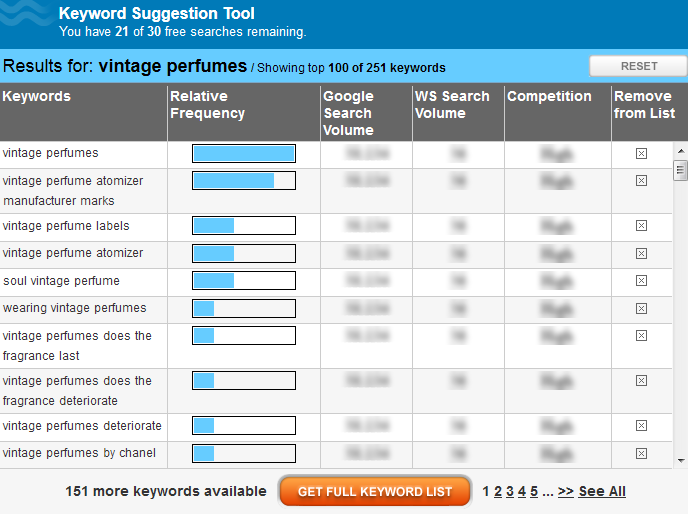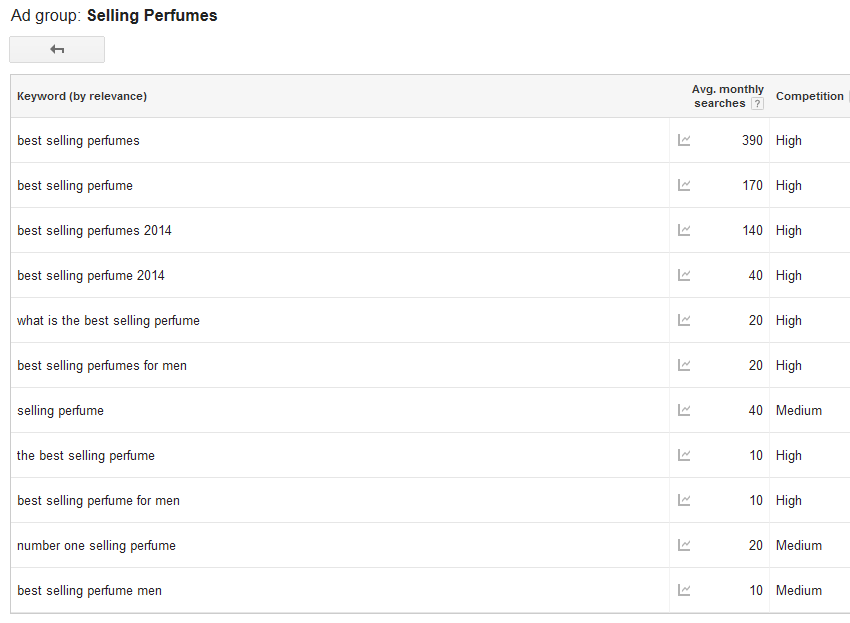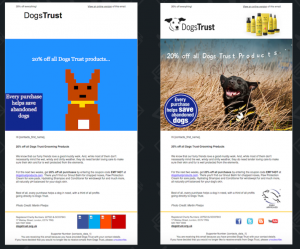As more and more brands become publishers, the competition for eyeballs on your content continues to grow. The web is now pretty much littered with blogs – some super successful and others … not so much.
What is it that makes a blog take off and become a hit with readers, to the extent that hundreds of thousands or even millions of viewers tune in religiously every month?
More importantly, what would it do for your business to have a million people reading your blog and sharing your content with other members of your target audience?

Recently, I partnered with Ginny Soskey from the HubSpot Blog to host a webinar packed with our best blogging tips – the very same strategies we use to reach millions of combined readers to our blogs every month. You can employ these tactical blogging tips on your own site to increase your readership and align your blog more effectively with your business goals. This guide is divided into four main sections:
- Part 1: Keyword Research Tips
- Part 2: Blog Management Tips
- Part 3: Blog Optimization Tips
- Part 4: Blog Promotion Tips
Are you ready? Let’s jump right in…
BONUS: Click here to download this guide as a FREE PDF!
Part 1: Why Keyword Research Is So Important To Your Blog Strategy
I started off the webinar by sharing my insider tips on using creative keyword research to tap into the topics that your potential audience is dying to read about.
Keyword research is the process of using tools and data to determine which keywords people are typing into search engines when they’re looking for content like yours. This is the absolute bare minimum content strategy you need to start building your blog presence.
If you’re just getting started with blogging and don’t really know what you’re doing, the best way to start is by identifying a list of keywords that are going to bring relevant visitors to your website. This will help make your blog content more discoverable, but it also helps drive your content types and topics. When you have no idea what to blog about, keyword research will serve as your guide.
Sometimes people get hung up on this idea that using keywords means you’re writing for Google bots and not for humans. But here’s the thing: keyword research would be really important for content marketing even if you didn’t care about organic search traffic. You should care about it, of course, but even if Google didn’t exist, keyword research would still be valuable, because keyword volume corresponds to subject interest.
If a lot of people are searching on a keyword, it means a lot of people are curious about that topic. If you then write about it, you’re not just going to get access to that potential search audience; you’re going to find that people are more interested in those blog posts when you share them on social media, through your newsletter and in other marketing channels. You’ll be creating the kind of blog content that people really want to read!
The super basic way to do keyword research is to go to a keyword tool, type in a topic and see what comes up. These are the results you get when you type “vintage perfume” into the WordStream keyword suggestion tool – you get a list of terms, plus an indication of their relative popularity.
If this is your process and it ain’t broke, don’t fix it.
For some people, however, it’s tricky to connect this type of keyword research up with finished content. One reason for this might be that the intent isn’t always clear from an isolated keyword. Also, depending on what tool you use, you might end up with a bunch of really competitive, broad terms with high search volume. These kinds of terms are basically impossible to rank for, because so many other sites are competing for the same terms.
Alternatively, you might end up with highly commercial keywords, which are great to target with ads or product pages but aren’t necessarily a good fit for a blog.
Let’s look at some creative ways to get keyword ideas that are a little more actionable, from a content marketing perspective.
Build Out Your Content Strategy With Keyword Planner
First, try using the AdWords Keyword Planner to find keyword topics broken down by specific keywords. This tool was built for AdWords advertisers looking for keyword groups to target with their PPC ads, but bloggers can hack it to come up with topic ideas for their blogs.
Just type in a starter keyword topic like you normally would, but focus on the first tab in the results, the “Ad group ideas” tab, where keywords are grouped into related clusters:
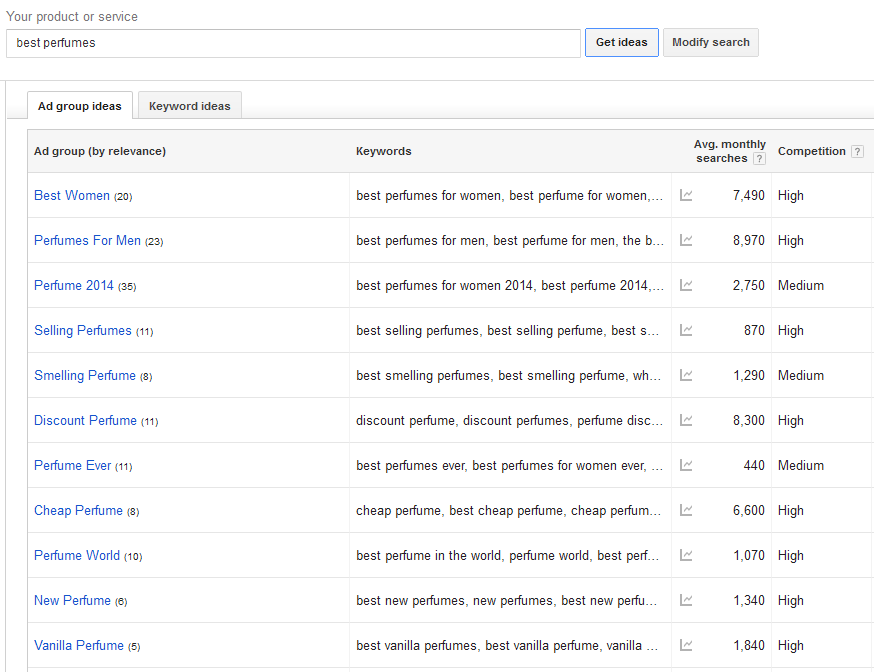
Here, you can click on a keyword and see all of the related keywords and terms, along with their competition and average monthly search volume.
This can give you a really good idea of the variations on a theme that people are searching for when they’re looking for information on any given topic. You can also get a much clearer idea of the intent of searchers by looking at groups of keywords they’re searching on, rather than just looking at a single keyword.
Take the example below. The term “selling perfumes” could potentially mean different things – maybe people are looking for information about becoming perfume sellers, or they want to know where to buy perfumes. But when you drill down into the group, the related keywords show you that many people are actually looking for lists of the best-selling perfumes. These insights can help you drive content strategy that better aligns with the types of information people are actually looking to find.
These clusters are really great for helping you structure long-form content like a guide, because the different keywords often suggest subcategories/subheads. (More on this later!)
(PS: You do need an AdWords account to use the Keyword Planner, but if you don’t have one, the Free Keyword Niche Finder performs a similar function.)
Using Keyword Planner For Competitive Blogging Inspiration
Here’s another way to hack the Keyword Planner: use it to copy content ideas from other sites in your niche. Note: I am not saying you should plagiarize from your competitors! You’re just getting inspiration from them.
Start by picking a site that you admire. For example, I really admire the Buffer blog and their “influence the influencers” strategy. If I copy their URL into the “your landing page” field in Keyword Planner, the tool provides keyword ideas based on the content Buffer is publishing.
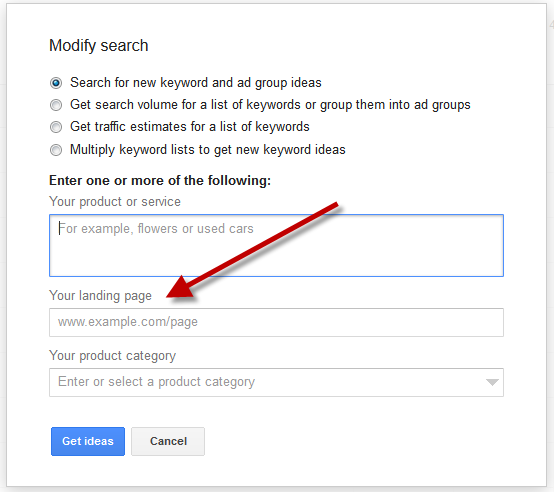
From here, you can focus on the “ad group ideas” tab or the “keyword ideas” tab – whichever you find more inspiring. Once you see a keyword you want to target, take the competitive research angle one step further and type that keyword into Google to see what’s already ranking on the first page. If you want to rank for this keyword and get clicks through from organic search, the content you create should be better than what’s already out there.
Pro Blogging Tip: Focus On Long-Tail & Evergreen Keywords
Why target long-tail keywords? These are the longer, more specific terms that have less search volume, but typically are less competitive, as well. If you’re an established site like HubSpot, you can probably get on the first page for some pretty competitive keywords, where there are hundreds or thousands of sites competing for the same keywords.
But if you’re not HubSpot, that’s going to be really tricky to pull off. It’s not enough to just write a good piece of content; you also need domain authority and a lot of links, things that take years to build. If you don’t have that much clout yet, you’re going to be much better off going for longer tail keywords, where it’s possible to rank with strong on-page optimization alone.
Another smart place to focus your efforts is on evergreen keywords. These are keywords that tend to have steady volume week over week and month over month.

It just keeps going and going and going…
For example, one of our top-performing blog posts of all time is called “12 Ways to Find Anybody’s Personal Email Address.” This drives traffic year after year after year, because the advice doesn’t expire and people are still interested in that topic. It’s both long tail and evergreen. Unlike trending keywords which spike and then die off, like “where to watch the World Cup,” evergreen keywords can drive regular, ongoing traffic to your site, and that’s how you can start to build a reliable traffic stream.
Tips & Tricks for Finding Long-Tail, Evergreen Keyword Ideas
One good way to find evergreen, long-tail keywords is to use Google Suggestions. There are the keywords that come up in a list under the search box as you type.

What these suggestions are showing you are popular searches that start with the words you’re typing. In essence, Google is trying to guess what you might be looking for based on popular search terms others have used. It’s a great way to see real search queries in action.
Another tip is to use an underscore to get suggestions for words that occur in the middle of a keyword string, like this:

Nifty, eh?
Another creative place to find keyword inspiration on the SERP is in Google’s Related Searches. These show up at the bottom of the page, under the results:
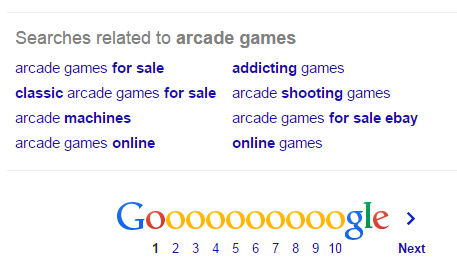
Google suggestions show you which popular search queries start with the words you’re typing, while these related terms show you other searches that people who searched for your main keyword (in this case “arcade games”) might have typed to refine their query. You’ll likely see some synonyms and variants here, as well as more specific keyword strings.
Here are a few more creative ideas for finding long-tail keywords:
- Keyword Referrals: Dig through your keyword referrals in Google Analytics (note that you’ll have to look at the lower volume keywords to find more specific long-tail terms) or Webmaster Tools.
- Q&A Sites: Browse sites like eHow, Yahoo Questions and Quora for topics. Questions make amazing keywords for blogging! For example, another of our most popular posts ever is called “How to Find Your Old Tweets.” Another one answers the question “What are the most expensive keywords in AdWords?” These were both questions that I had myself and couldn’t find satisfactory answers to, so I answered them myself! If you’re an expert, you can probably create content to answer these questions better than most of these Q&A sites, where anyone and everyone can contribute.
- Wikipedia: Check out the “table of contents” on any given page, as well as the “See also” section at the bottom,; these are full of keywords. In general, Wikipedia is a great model for SEO – they kill it with organization, internal links and other on-page optimization factors.
Once you have you keyword list, you can use it to build out your content calendar for a few weeks. Remember, if you’re creating content that aligns with keywords people are searching on, you’ve got a built-in audience just waiting to discover your expertise.
Part 2: Expert Blog Management Tips With Ginny Soskey
Next let’s talk about your content creation process. All of the research and inspiration in the world is great, but you need a process in order to execute.
One of the most common questions we hear is this: how often should we be publishing?
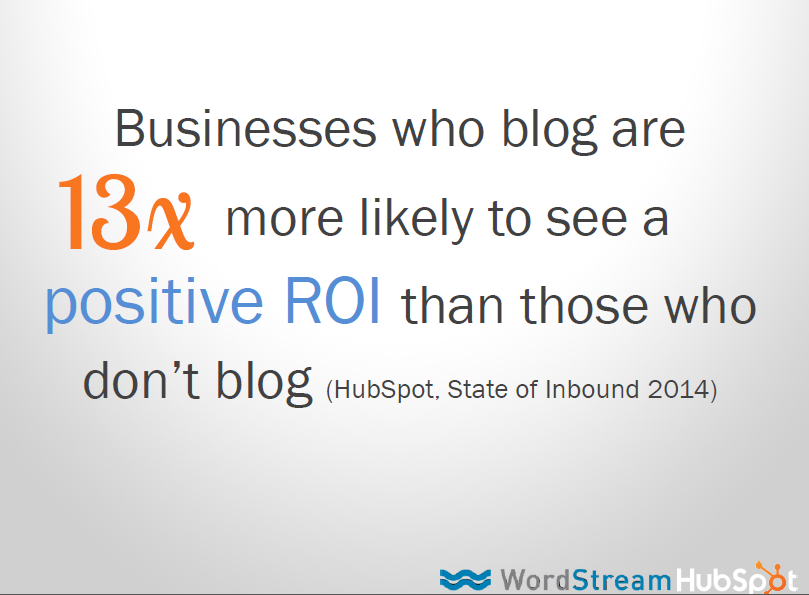
HubSpot research shows that businesses that blog are 13x more likely to see a positive ROI than those that don’t. We recommend that businesses try to blog at least twice weekly to see results from their efforts. If you can do more, definitely do!
However, whether you’re publishing once a month or every hour, you need to develop and stick with your content process.
The first step in execution is great planning and for that, you need an editorial calendar. This tells you which day and time of day you’ll publish, what the topics are, and who is responsible for writing each post.
Developing An Editorial Calendar & Idea Repository
It’s really easy to put off blogging when you have so many other things on your plate, so keeping track of your commitments is important. Using an editorial calendar can also help you track results and prove value to others in your company. HubSpot offers a free, downloadable editorial calendar template you can use to get started right away.
If you don’t like Excel, you can use other free tools, like Google Calendar. Whatever tool you use, the important thing is to have one and use it religiously.
In a perfect world, we would never run out of things to blog about. In reality, however, it’s tough to come up with a steady stream of blog ideas. You need to have a backup plan.
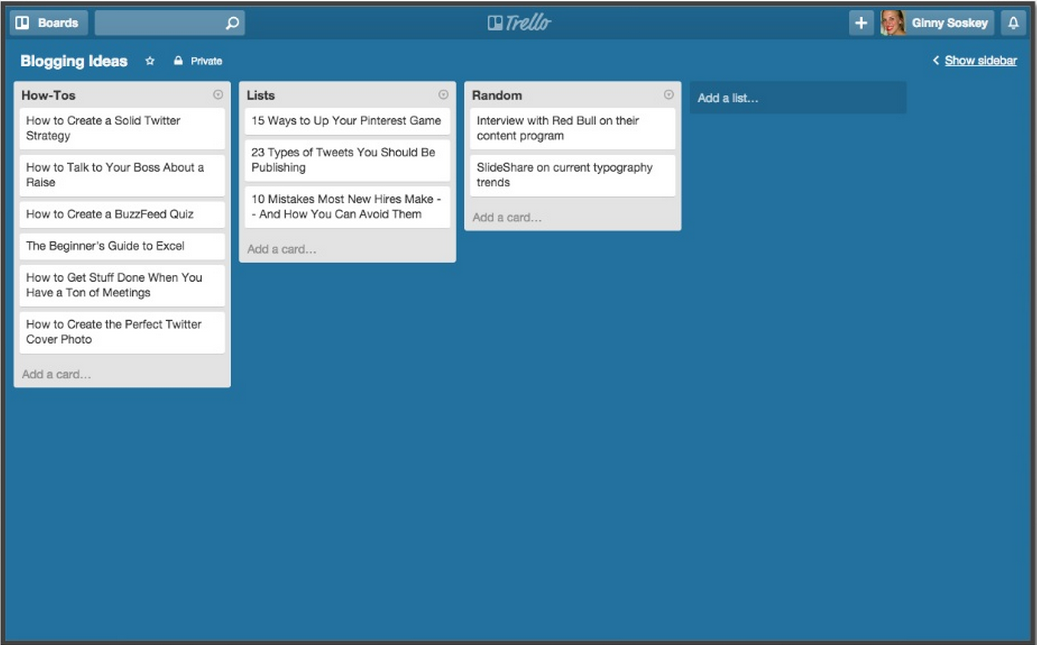
HubSpot keeps a backlog of blog post ideas using Trello. As you can see above, they use it to categorize ideas so when they are searching for something to write about, they can choose the type of post that fits in the calendar on the open date. They have ideas backlogged for How-To posts, List posts, Random posts, etc.
While you’re researching keywords, keep track of specific ideas in your backlog. If you find that you’re getting ideas while you’re brainstorming, you can leave notes in your Trello cards, such as links to research, notes for blog authors, etc.
Pro Blogging Tip: Switch Up Your Content Types
Variety is the spice of life! Most people think of blog posts as text-based content and that’s true for the majority of posts, but those are very time-consuming to write. You need to discover other content types that your audience appreciates and that use fewer resources to produce.
For example, HubSpot’s audience loves well-done infographics, so they feature one every week. When they find a really good one that they want to feature, they put it in the Trello backlog so it isn’t forgotten. These posts are really quick to put together and people find the visual information really valuable.
HubSpot has also put together a group of content templates to help bloggers ease the process of getting into new content types. You can download these six content templates free and use them to create more variety in your blog posts.
Organize Your Email Inbox For Inspiration & Productivity
As you start to create more content, you’re going to get a ton of blog-related email. Your team members will have questions for you about the blog posts they’re writing. You’re going to get pitches from people and companies who notice you write about topics they’re interested in. Your volume of email will increase exponentially and you don’t want it to become overwhelming.
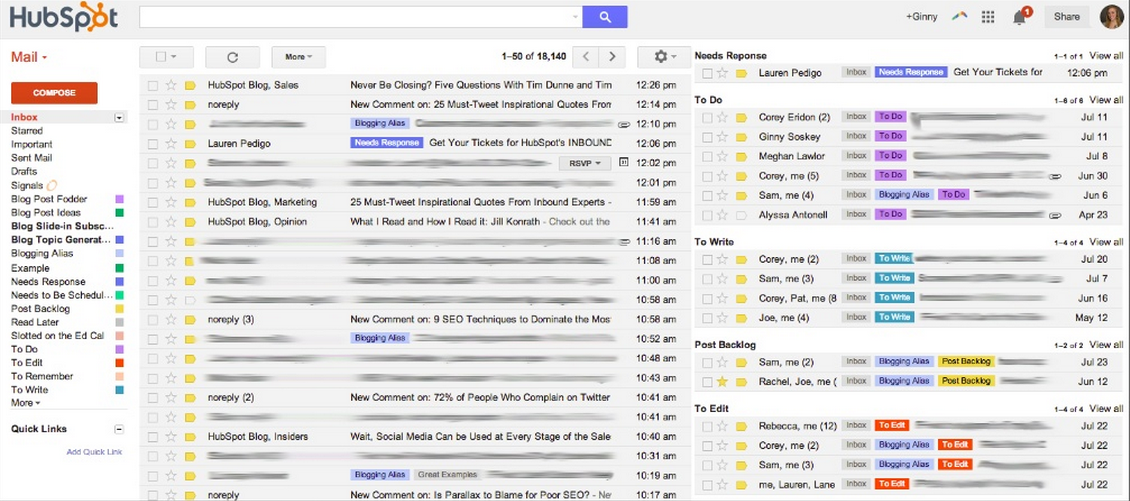
Most email programs have some sorting features and capabilities that can help make your life as a blogger simpler. In the above example, we’re using Google Apps for email, but Outlook and other programs offer similar features.
In Gmail, we have multiple inboxes to help triage emails as they come in. You can sort emails as they come in, using color-coded inboxes, then go through them in order of priority throughout your day as you have time.
Before we move on, let’s just recap the keys to expert blog management:
- Create (and use!) an editorial calendar.
- Keep a backlog of blog content ideas handy so you never run out of things to publish.
- Vary the types of content you post to keep it interesting for readers and ease your creation process.
- Keep your email inbox organized to enhance productivity and keep track of blog activities.
Part 3: Blog Optimization
Next let’s talk about blog content optimization – the practice of actually putting your keywords to work in your content, increasing the chances that you’ll be able to rank for those keywords and drive ongoing organic traffic.
The first step in blog optimization is keyword prioritization.
When you’re evaluating a group of related keywords, your main keyword should be the one with the most traffic volume. In the cluster we looked at before, the highest volume keyword in the bunch was “best selling perfumes”:
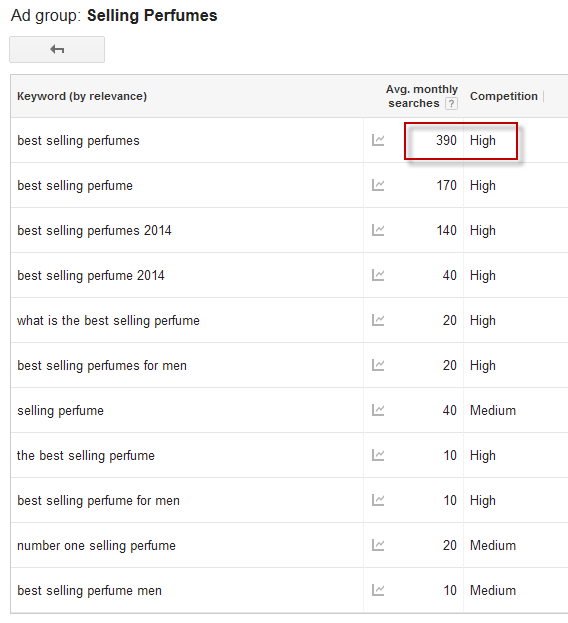
The two most important places for this keyword to appear are the URL and the title of your blog post. This demonstrates to Google the relevance of your content to the searcher’s query. For example:
URL: yourbusiness.com/blog/best-selling-perfumes
Title: Best Selling Perfumes of 2014
Pro Blogging Tip: Take The Time To Write Awesome, Optimized Headlines
A great headline is an art form; it can really make a difference in how many people see, click, and read your blog post. You know your headline should include your main keyword, but once you’ve ticked off that box there is a lot more you can do to entice people to click and read. (Again, the headline will come into play across all your channels: SEO, email, social, etc.).
Here are some tips for creating more awesome headlines:
- Use lists. I know you’re thinking “lists are over!” but they’re NOT. Our top articles from the past year have all started with a number!
- Create curiosity. Don’t give everything away. You want people to see your headline and feel like they just have to click.
- Make it clear that your content is actionable. “5 Ways You Can Save $ 50 Today” makes it sound like you’ll walk away with something you can actually do, versus something vague like “Managing Your Budget.”
- Address your reader directly. E.g. “5 Emergency Tools You Should Never Leave Home Without.”
How To Keyword-Optimize Your Blog Posts
There’s actually a lot you can do to keyword-optimize your page without resorting to so-called “keyword stuffing.”

If you’re writing your content with the keyword in mind, it should naturally occur in the body text a few times. But don’t forget about:
- Subheadings
- Image file names and alt text
- Anchor text
- The meta description
What’s great is that optimizing your page for search and formatting your page for online readability really go hand-in-hand.
More images give you more opportunities to use different variations on your keyword, and it also breaks up the text and makes it more engaging (just make sure they’re relevant!).
Similarly, subheadings and stuff like bullet lists and bold text make your text more scannable and are great places for keywords.
Optimizing Subheadings In Blog Content
Let’s zoom in a little on the idea of subheadings for a minute. Remember those long-tail, related keywords we snagged from Keyword Planner and the bottom of the search results page? They can help determine the structure of your content.
It’s a really good idea to look at a group of related keywords and use them to create an outline for your blog post or guide. For example, take a look at an ad group like this (obtained by plugging in the Buffer blog URL!):
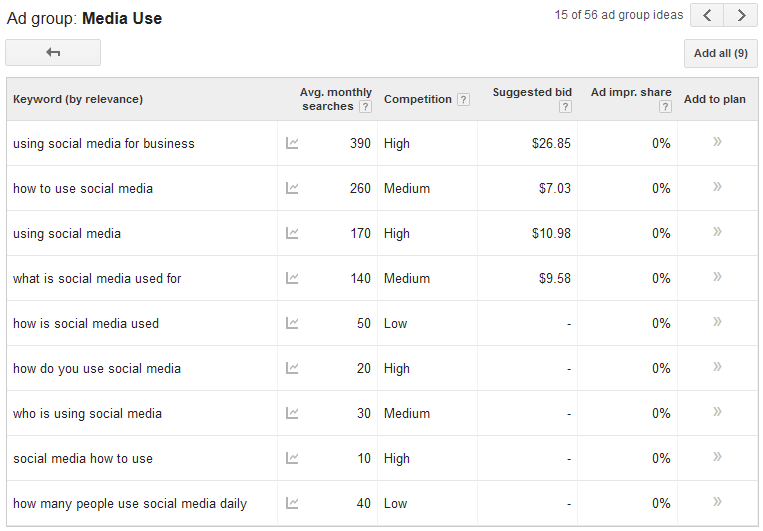
This could translate into an outline like this:
TITLE: Guide To Using Social Media For Business
- Intro: How many people use social media daily? (Illustrate size of market, why it’s valuable)
- Who is using social media? (Why is this audience relevant to your business and target market?)
- What is social media used for? (What social networks are potential customers using to find products and services like yours, reviews, tips, and more? How are businesses using social media for fun & profit?)
- How to use social media (Tips for using social media to market a business, promote your brand, drive leads, sales, etc.)
See how those keywords translate directly into subheadings and section titles? This actually does part of the organizational work for you!
We’ve found that by including these related keywords in your content, you can really improve your rankings – it’s a strong signal to Google that your content is valuable to users and aligns with what they’re looking for.
Pro Blogging Tip: Use Internal Linking
Another underused tactic is internal linking. Every time you create a new blog post, you should find five or more existing pages on your site you can edit to link to your new post, using relevant anchor text.
There are a lot of benefits to internal linking:
- It makes your site stickier. People are more likely to stay on your site when there is somewhere else to go that is also relevant their interests. Consider linking to related posts under each blog post, and having a sidebar that features your most popular content.
- It’s a form of passive link building. When people link to your content or syndicate it or copy and paste a quote, they often leave those links intact! In this way, internal links become external links.
- It helps you plan future content. If you find yourself repeatedly referring to a certain concept, plan to devote a blog post to it so you can link to that new blog post from all those previous mentions. For example, we found that we kept talking about the concept of the target market or target audience, so we wrote a post defining what that concept is and how to find your own target audience.
Pro Blogging Tip: Follow Up Your Most Popular Posts With New Content
Building off that last tip, you can improve your content promotion by writing follow-up articles to your most popular posts and linking back to the original article.

This is a great way to build momentum, rank for keywords related to the original keyword you targeted, and help establish your brand as a thought leader in a niche. For example, if you wrote a blog post about why Helvetica is a bad font choice for signage and it got a lot of traction, you could follow up with a post about the best fonts for signs.
Think of these posts like sequels or spin-offs. If you do this enough, you can really start to dominate your space.
Don’t Forget About Post-Publish Optimization
The more you can do to optimize your post for organic search before you publish it, the better, but don’t forget about post-publish optimization.
Periodically check to see where you’re ranking for the keywords that you’ve been targeting. There are tools for this but you can do it manually, as well. Use an incognito browser (so the results are minimally personalized), google the keyword and look for your content.
If you can push something from the second page to the first page, or from the bottom of the first page to the top, you’re going to see the most benefit. Go back in and see if there’s more you can do to move the ranking:
- Does the keyword appear enough times?
- Can you include more related keywords?
- Can you build more external links with some targeted outreach?
- Can you better address the intent of the keyword? (Are the articles on the first page answering the question better than you did?)
Part 4: Get Eyeballs On Your Awesome, Optimized Blog With Content Promotion
Aside from organic search, there are a ton of things you can do to optimize your blog posts for better promotion and sharing. Here are Ginny’s best tips for blog content promotion, starting with social promotion optimization.
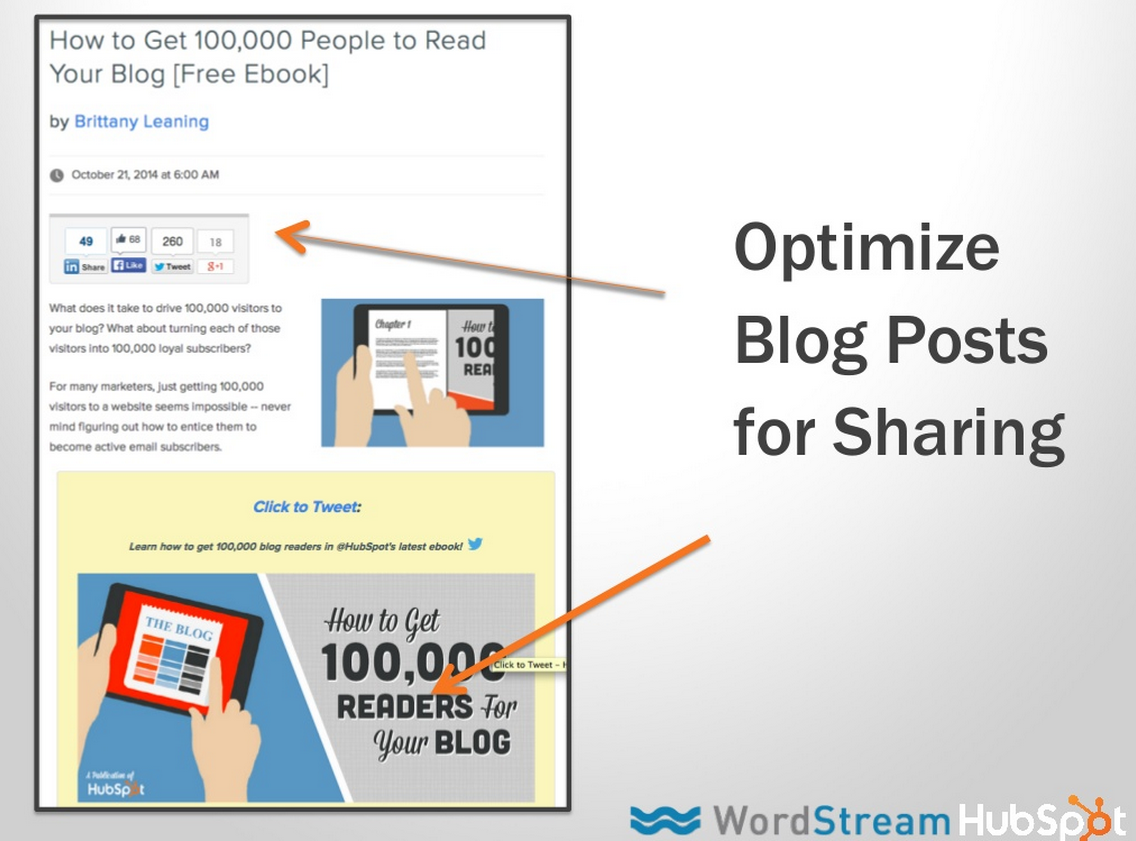
Every blog post on the HubSpot blog is optimized for social sharing with highly visible share buttons. Once you have a bit of a blog audience built up, make sure you have share counts published on your buttons. It’s an important form of social proof that shows readers just how many other people also shared the content and is huge in building credibility. Studies show that people are more likely to “like” or reshare if they see that lots of other people already have done so.
In the example above, you’ll also see the yellow box with the Click to Tweet link. When a reader clicks on the box, they can tweet out a message the blog creator has already written. This makes it really quick and easy for people to quote your post without having to copy and paste, or even think about finding a good tweet-length quote!
Add A CTA & Subscriber Sidebar To Build A Base Audience
Other elements HubSpot includes on all blogs to optimize for promotion and retention are a call-to-action (CTA) box and a subscriber sidebar.
The CTA box is at the bottom of each post and offers something of value for the reader – an ebook, a whitepaper, etc. Clicking on the box sends the reader to a landing page with more content.
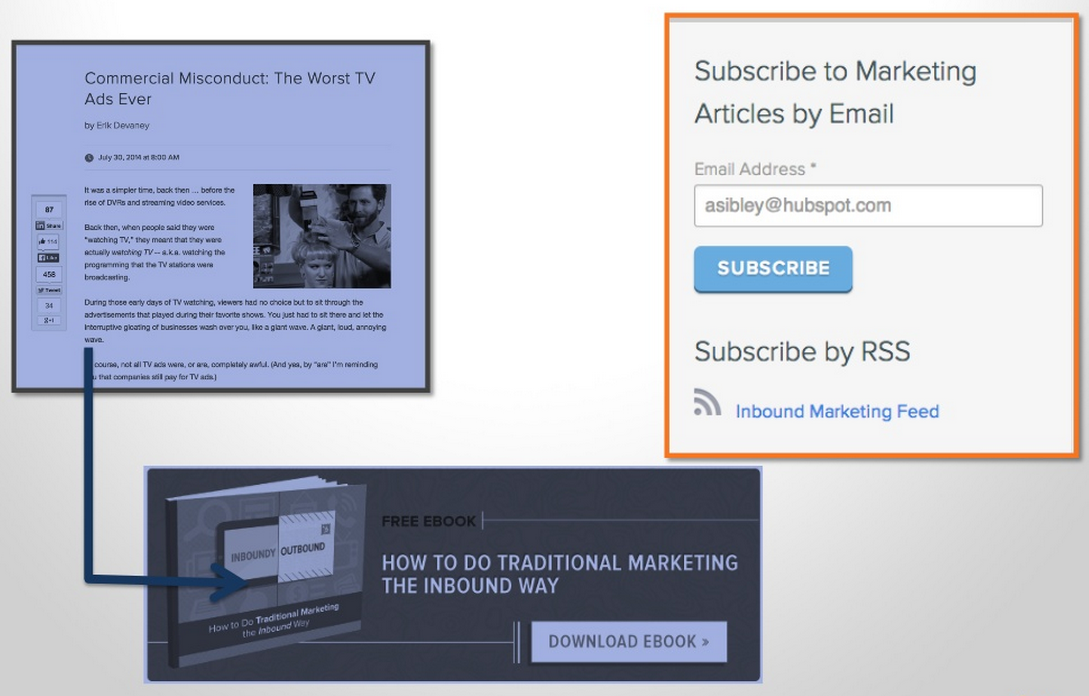
Yes, this takes them off your blog, but if you create good content across the board, you’re going to be their preferred source next time they’re looking for information.
It’s also important to have a subscriber bar – HubSpot has it in the sidebar, but it can go anywhere on your blog. Building a subscriber base gives you a core audience for each new blog post you write. The CTA box and subscriber option are both important in building that base. People can choose to opt-in as a subscriber, or you can get them to opt-in by offering them something of value. Either way, it helps you build that audience base you can then promote new content as it publishes.
Smarter Social Media Promotion
Definitely start by focusing on the Big 3 social networks: Twitter, Facebook, and LinkedIn. You may find smaller, niche networks that turn out to be decent traffic drivers for you, but when you’re getting started, you want to have the Big 3 covered. Your analytics will help you decide where you should really focus your efforts. For example, search marketers tend to hang out on Google+, so that’s a valuable network for us.

Optimizing your images and visual content is critical for social promotion. On Twitter, images with your tweets automatically appear in the feeds of users, and we’ve found at HubSpot that tweets with images generate 31% more visits.
When you post a link on Facebook, the accompanying image is huge and dominates the space on the newsfeed. Your images should be large, high-resolution, and eye catching for best effect. Each social network has its own optimal size and resolution for images, so make sure your image is optimized for each network you use for sharing.
Content Promotion Through Email
Each time a new blog post is published on the HubSpot blog, subscribers are notified via email:
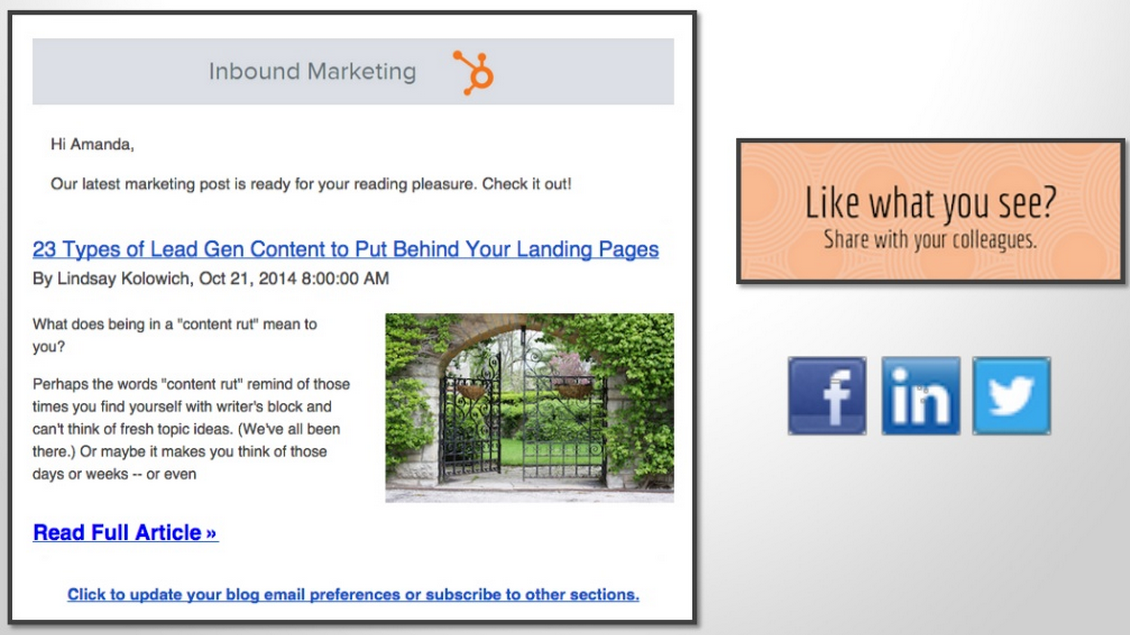
As you can see, the promotional emails are optimized for social sharing. You want to make it as simple as possible for your readers to share your new content with their own social networks. You can also include a call to action to encourage them to share it with their colleagues via email. Even though these people are already in your database, you want to get them to work as advocates, sharing your content with others in a domino effect.
Effective Paid Promotion For Blog Content
People often think that inbound marketing is 100% organic and doesn’t include paid promotion, but if you align paid with organic and do it properly, the results can be fantastic:
- One effective paid content promotion tactic is social amplification. You’ve already created your content; now boost the post by promoting it on Facebook, or Sponsor a Tweet to help get it off the ground. This allows you to reach out to a targeted audience beyond your own network, across social sites, and can then trigger a lot more shares organically.
- Another paid tool to try is Outbrain. It allows you to have relevant blog posts placed on other publishers’ blogs. You won’t get placed on competitor sites, but on topical sites where readers are already looking for more content like yours.
- A third paid option is content remarketing. This is where you reach people who have already visited your website through paid ads that appear to them as they move around the web. Visitors to your website are tagged and then targeted with customized messaging as they check their email, watch YouTube, do searches, etc. This is a highly cost-effective way to convert people who have already found your blog.
Promoting Your Blog Content On Your Own Website
How do you get your website visitors into your blog? There are four main places you should focus your efforts for internal promotion:
- The homepage
- Related product pages
- Subscriber page
- Content downloads
On your homepage, you can feature a relevant blog post with a call to action, but at the very least, you should be linking people to your blog from the top navigation menu.
On your product pages, you might assume that people are already well educated about your products and don’t need to go back to the blog to learn more. They’re far enough along in the funnel by the time they reach your product pages. However, the buying process isn’t always linear; just because they’re on your product pages, it doesn’t mean they aren’t interested in any more content at all. You may see natural opportunities to link back to specific blog posts, or sections of your blog, from specific product pages.
Make a landing page just for your blog subscribers. This is a great place to link to any marketing promotions you have going on and to link back to specific blog content. These landing pages also rank in Google, so be sure to have unique, original content here.
Finally, use blog content at the end of the content download process. Your reader fills out a form and downloads the content (an ebook, a report, etc.). Use the download page to encourage social sharing, but also to promote other relevant content they might find relevant.
Building A 1 Million-Strong Blog Presence With HubSpot & WordStream
Use the keyword research, content creation, blog optimization and promotion tips from this guide to start building a better blog strategy! Don’t stop there, though. Check out the WordStream Blog for the latest paid search and online marketing news and tips and stay current with inbound marketing trends on the HubSpot Blog.
Digital & Social Articles on Business 2 Community
(484)
Report Post
